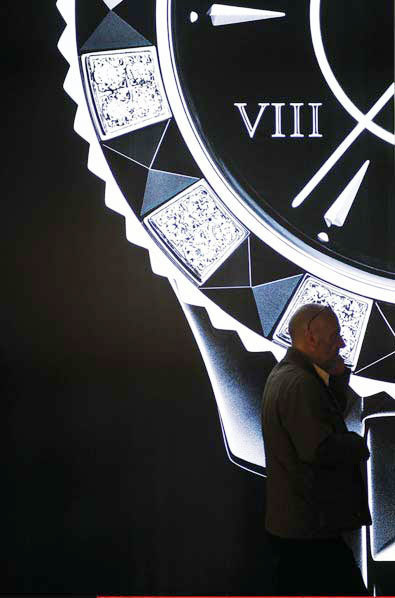Watchmakers seize the hour in China
Updated: 2012-01-30 10:41
By Xu Junqian (China Daily)
|
|||||||||
HANGZHOU - The robust growth of the Chinese luxury market has seen high-end brands expanding their territory in the fashion industry to keep enticing consumers.
The watch and jewelry sector, which has generally been defined as "hard luxuries", has become a new growth area for brands such as PPR SA's Gucci unit and Louis Vuitton Moet Hennessy (LVMH) SA that have not traditionally specialized in the field.
|
 |
|
A visitor passes a booth at the BaselWorld watch and jewelry fair in Switzerland in early 2011. Some European watchmakers have started to fret about the luxury watch market tilting dramatically toward emerging markets, including China.[Photo/China Daily] |
"It's a very interesting and, of course, important market in China," said Michele Sofisti, the newly appointed CEO of Gucci's Global Timepieces & Jewelry business, in Hangzhou, the capital of Zhejiang province.
Switzerland-based Sofisti was in what he described as the "beautiful ancient city" known for its majestic West Lake to kick off a music fund with China Soong Ching Ling Foundation that is intended to help young Chinese talent. China is the second country after the United States to receive support of this kind from Gucci.
"There are lots of opportunities for hardworking young people, and they are the real driving force here," said Sofisti, who worked for Swatch Group, Fred Jewellers and Christian Dior SA watches at LVMH before arriving at Gucci. "We believe that, like music, watches have a timeless and international appeal."
Statistics from the global advisor Bain & Co show that watches and jewelry have taken the place of perfume and cosmetics, becoming bestsellers in China since 2010, leading the market with an annual output of 20 billion yuan ($3 billion) in 2010.
Unsurprisingly, Gucci, one of the top three "most desirable brands" in China, as ranked by Bain, has seen a similarly promising increase in sales, with "double-digit growth" in its watch and jewelry sector every year in China, according to Sofisti.
One of the advantages for the company, Sofisti believes, is the "strong brand awareness" among Chinese consumers, although dedicated manufacturers such as Rolex Watch Co and Omega Watch Co still dominate the market.
"Unlike the traditional watchmakers' expertise in mechanics or function, we are trying to combine quality and design into the watches, bringing a timeless appeal to them," said Sofisti, who thinks the 40-year-old Gucci watch has gone far beyond being simply a "fashion accessory".
Other newcomers, however, have adopted a similar method. The French fashion house Chanel SA, for example, has recently been bombarding potential consumers with its latest J-Chromatic watch collection, which boasts a combination of both high-end materials and premium jewelry.
Meanwhile, the French luxury conglomerate LVMH has been planning something more strategic. An extremely powerful force in the luxury and fashion industries with 60 brands, LVMH took control of the Italian jeweler and watchmaker Bulgari Time SA in March last year. Many industry insiders said the move indicates the company's ambitions to tap into the emerging markets in Asia such as China, where Bulgari has drawn the vast majority of its sales. It is expected that the acquisition will help LVMH's watch and jewelry businesses better share the fruits of the Chinese market, which, including the LVMH unit, Tag Heuer, and Zenith SA, accounted for only 20 percent of its business in Asia.
"For many in China, a watch has not only been the ultimate status symbol. It may also resemble the character of a designer bag in its artistic value and, perhaps, an apartment in its investment value," said Wang Ji, the creator of Time & Art magazine.
"China has actually become the central topic at top trade events such as BaselWorld," added Wang.
Numbers from the Federation of the Swiss Watch Industry show that China became the world's third-largest market for Swiss watches in 2011, with the highest increase in sales, 47.8 percent, among all markets. Hong Kong has remained the top market with the largest number of orders for Swiss watches since 2008.
Even the traditionally popular brands have been introducing new models to lure wealthy Chinese customers.
Kevin Rollenhagen, president of Omega SA's Greater China division, acknowledged that the brand has especially introduced a large number of watches decked out with diamonds because timepieces of this type have been selling like hot cakes in China, although traditionally, diamond-encrusted watches have not been popular in Europe.
However, some European watchmakers have started to fret about the unbalanced development of the luxury watch market as producers focus on the emerging markets, raising concerns that the century-old industry will become a business "tailor-made for China".
Related Stories
Stars to watch 2011-07-10 07:54
Time to sell 2011-01-06 07:56
10 Most Watched in 2010 2010-12-20 13:26
Cyma will not bide its time in China 2011-06-25 09:26
Watch company finds its time to start expanding 2010-12-20 09:25
- China's largest electric car charging station opens
- TV through the Internet steps forward
- Shandong tops China's labor export list
- Cities see surge of returning workers
- Tourism revenue up 24% for Spring Festival
- Spring Festival sparks a 'gold rush' in China
- Foreign ports lure Chinese travelers
- Property tax cools high-end housing market








